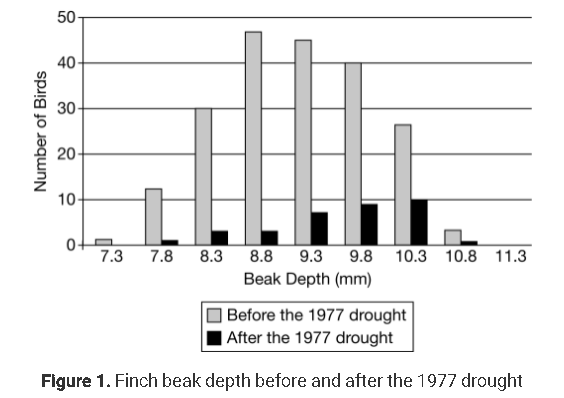Your cell phone should be away during all
times today unless you are viewing the website.
Journal Entry:
Finch beak depth was measured before and after a severe drought
in 1977. The averaged results are shown in Figure 1. After the drought, there
were fewer seeds available for the finches to eat and the seeds that did remain
were larger and harder to crack open. Researchers claim that when large, hard
seeds are the predominate food source, the average beak depth of these finches
tends to increase in subsequent generations.
Using the evidence provided, which of the following best
justifies the researchers' claim?
A) Finch
beak depth increased after the drought because the overall numbers of finches
decreased, reducing competition for resources.
B) Finch
beak depth increased as a consequence of selective pressure after the drought
because the remaining seeds were larger and harder.
C) Finch beak depth increased after the drought due to intraspecific
competition since finches with deeper beaks attract more mates.
D) Finch beak depth increased after the drought due to increased
predation since finches with deeper beaks can fight off predators more effectively.

Learning Intentions
-
You can describe how genetic drift occurs in
small populations.
-
You can analyze how the reduction of genetic variation within a given
population can increase the differences between populations of the same
species.
-
You
can describe how different factors within a population can
influence evolution of a population through a population genetics computer
simulation.
-
You can describe the founder effect
and bottleneck effect and their influence on population genetics.
Content Standards being covered:
Topics:
EVO-1.K Describe the conditions under which allele and genotype
frequencies will change in populations.
EVO-1.L Explain the impacts on the population if any of the conditions of
Hardy-Weinberg are not met.
SYI-3.D Explain how the genetic diversity of a species or population affects its
ability to withstand environmental pressures.
Science Practices:
3.B State the null or alternative hypotheses, or predict the results of an
experiment.
5.A.a Perform mathematical calculations, including mathematical equations
in the curriculum.
6.C Provide reasoning to justify a claim by connecting evidence to biological
theories.
Habits of Mind/Life skills being covered:
Applying past knowledge to current situations
